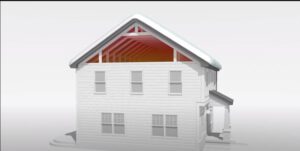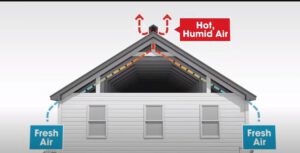 Proper ventilation is crucial for maintaining a healthy and functional attic space in Australia. Inadequate ventilation can lead to a buildup of heat, moisture, and pollutants, causing various issues such as mold growth, poor air quality, and structural damage. To ensure the longevity and usability of your attic space, it is essential to implement effective ventilation strategies. In this article, we will explore the key considerations and methods to ensure proper ventilation in your Australian attic space.
Proper ventilation is crucial for maintaining a healthy and functional attic space in Australia. Inadequate ventilation can lead to a buildup of heat, moisture, and pollutants, causing various issues such as mold growth, poor air quality, and structural damage. To ensure the longevity and usability of your attic space, it is essential to implement effective ventilation strategies. In this article, we will explore the key considerations and methods to ensure proper ventilation in your Australian attic space.
Understand the Importance of Attic Ventilation
Attic ventilation plays a vital role in maintaining a balanced airflow within the space. It allows for the exchange of stagnant air with fresh air from the outside, preventing the buildup of heat and moisture. Proper ventilation helps regulate temperature, reduces the risk of moisture-related problems, and promotes better air quality. Additionally, it can contribute to energy efficiency by minimizing heat transfer between the attic and the rest of the house.
Evaluate Existing Ventilation
Before implementing any changes, it is important to assess the current ventilation system in your attic. Check for the presence of vents, including soffit vents, ridge vents, gable vents, or turbine vents. Determine if they are functioning properly and if they provide adequate airflow. Evaluate the balance between intake vents (allowing fresh air in) and exhaust vents (allowing stale air to escape) to ensure proper air circulation.
Consider Climate and Environmental Factors
The climate in different regions of Australia varies, and considering local weather patterns and environmental factors is crucial when planning attic ventilation. Regions with high humidity levels, such as coastal areas, may require additional ventilation to mitigate moisture-related issues. Understanding the prevailing wind direction can help determine the best locations for intake and exhaust vents, ensuring efficient airflow.
Incorporate Intake and Exhaust Vents
A well-designed ventilation system requires a balanced combination of intake and exhaust vents. Intake vents, such as soffit vents or eave vents, are typically located at the lower portion of the attic and allow fresh air to enter. Exhaust vents, such as ridge vents, gable vents, or powered attic fans, are positioned at the highest point of the roof or along the roof slope to facilitate the escape of hot air. Installing a combination of these vents promotes natural airflow and ventilation.
Soffit Ventilation
Soffit vents are an essential component of attic ventilation systems. They are installed in the eaves or soffits of the roof, allowing cool air to enter the attic space. Soffit vents are typically paired with ridge vents or other exhaust vents to create a continuous airflow. It is important to ensure that soffit vents are not obstructed by insulation or other materials, as this can impede airflow.
Ridge Ventilation
Ridge vents are an effective way to provide exhaust ventilation in the attic. They are installed along the ridge line of the roof, allowing hot air to escape. Ridge vents work in conjunction with intake vents to create a natural convection effect, where cool air enters from the intake vents and hot air rises and exits through the ridge vents. Proper installation is crucial to ensure a watertight seal and optimal airflow.
Consider Attic Fans
 In certain cases, especially in areas with limited natural ventilation or excessive heat buildup, attic fans can be installed to improve airflow. Attic fans, powered by electricity or solar energy, help expel hot air and promote air exchange. They can be used as exhaust fans or in combination with intake vents to enhance ventilation effectiveness. However, it is important to properly size and position attic fans for optimal performance.
In certain cases, especially in areas with limited natural ventilation or excessive heat buildup, attic fans can be installed to improve airflow. Attic fans, powered by electricity or solar energy, help expel hot air and promote air exchange. They can be used as exhaust fans or in combination with intake vents to enhance ventilation effectiveness. However, it is important to properly size and position attic fans for optimal performance.
Insulation Considerations
When addressing attic ventilation, it is important to consider the impact of insulation. Insulation is vital for maintaining energy efficiency and preventing heat transfer. However, improper installation of insulation can block airflow and hinder ventilation. Ensure that insulation materials are not blocking or covering vents. Use proper insulation baffles to maintain a clear pathway for air movement from intake vents to exhaust vents.
Seek Professional Advice
Achieving proper attic ventilation can be a complex task, and seeking professional advice is highly recommended. Consult with a qualified roofing contractor, architect, or ventilation specialist who can assess your specific attic space, consider local regulations and climatic factors, and provide expert recommendations for the most suitable ventilation system for your needs.
Conclusion
Proper ventilation in your Australian attic space is essential for maintaining a healthy and functional environment. By understanding the importance of attic ventilation, evaluating existing ventilation, considering climate and environmental factors, incorporating intake and exhaust vents, utilizing soffit and ridge ventilation, considering attic fans when necessary, addressing insulation considerations, and seeking professional advice, you can ensure optimal airflow and prevent potential issues associated with poor ventilation. By implementing effective ventilation strategies, you can create a well-ventilated attic space that promotes air quality, minimizes moisture-related problems, and contributes to the overall comfort and longevity of your home.
